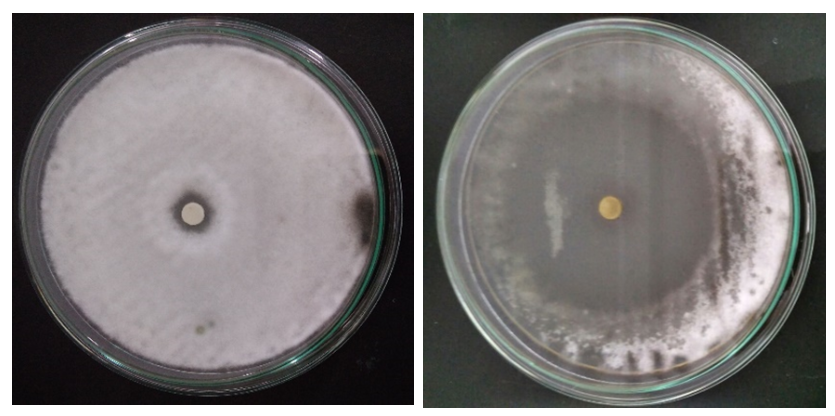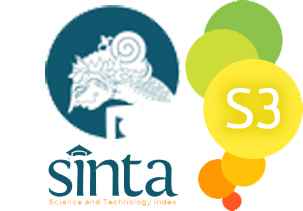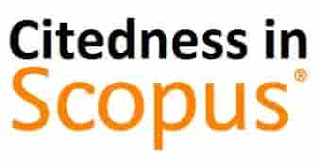Effect of Ethanol Extract from Clove Flower (Syzygium aromaticum) on the Growth of Trichophyton rubrum in vitro
Abstract
Indonesia is one of the countries with a tropical climate that has high temperature and humidity, a good atmosphere for fungal growth so that fungi can be found somewhere. Fungus Trichophyton rubrum is a fungal disease that attacks the nails, skin, hair. One of the preventions of this disease is by giving traditional medicines, namely clove flowers (Syzygium aromaticum) which contain chemical compounds saponins, tannins, flavonoids. Serves as an antioxidant that can prevent dermatosis. The purpose of this study was to determine the inhibition power of clove flowers (Syzygium aromaticum) on the growth of Trichophyton rubrum fungi. This research was carried out an experimental method with the Kirby Bauer method. Concentration dilution of clove ethanol extract (Syzygium aromaticum) from concentration 10%, 20%, 30%, 40%, 50%, 60%, 70%, 80%, 90%, 100%. The results of this study showed that the clove ethanol extract (Syzygium aromaticum) inhibit the growth of Trychophyton rubrum fungus from the concentration of 10% inhibition zone 14 mm, 20% inhibition zone 26 mm, 30% inhibition zone 36 mm, 40% inhibition zone 41 mm, 50% 45 mm inhibition zone, 60% 46 mm inhibition zone, 70% 48 mm inhibition zone, 80% 49 mm inhibition zone, 90% 51.0 mm inhibition zone, 100% inhibition zone of 56 mm.
References
DOI: 10.15294/sainteknol.v13i2.5240
Alma, M.H., Ertras, M., Nitz, S., & Kollmannsberger, M. (2007). Chemical Composition and Content of Essential oil from the Bud of Cultivated Turkish clove (Syzygium aromaticum L.). BioResources, 2(2):265-269
Andries, J. R., Paulina, N. G., & Aurelia, S. (2014). Uji Efek Anti Bakteri Ekstrak Bunga Cengkeh Terhadap Bakteri Streptococcus mutans Secara in Vitro. Jurnal e-GiGi (eG). 2 (2).
DOI: https://doi.org/10.35790/eg.2.2.2014.5763
Chandra, B. 2006. Pengantar Kesehatan Lingkungan. EGC. Jakarta
Cortes-Rojas, D.F., de Souza, C.R.F., & Oliveira, W.P. (2014). Clove: (Syzygium aromaticum). Asian Pacific Journal of Tropical Biomedicine, 4(2):90-96.
Costa, A. G, Cícero Deschamps, Lilian Cristina Cocco. & Agnes de Paula Scheer. (2008). Vegetative Growth, Yield And Essential Oil Of Patchouli Subjected To Different Levels Of Nitrogen Fertilizer In The Planting And Maintenance. Biosci. J., Uberlândia 30 (2) : 387-392.
Cui, H., Zhang, C., Li, C., & Lin, L. (2019). Antibacterial mechanism of oregano essential oil. Industrial Crops and Products, 139: 111498
Harborne, J.B. (2006). Metode Fitokimia: Penuntun Cara Modern Menganalisis Tumbuhan (alih bahasa: Kosasih Padmawinata & Iwang Soediro). Penerbit ITB. Bandung.
Hezmela, R. (2006). Daya antijamur ekstrak lengkuas merah (alpina purpura K, Schum) dalam Sediaan salp. Skripsi. Fakultas Teknologi Pertanian Institut Pertanian Bogor, Bogor.
Khusnul, R.H. & Kusmarini, W. 2017. Uji efektifitas Ekstrak Etanol Rimpang Lengkuas (Alpiana Galanga L) Terhadap Pertumbuhan Jamur Trichophyton rubrum secara invitro. STIKes Bakti Tunas Husada Tasikmalaya. Jurnal Kesehatan. 17:(1) 73-80.
Lova, I. P. S. T., Wijaya, W. A., Paramita, N. L. P. V., & Putra, A. A. R. Y. (2018). Perbandingan Uji watAktivitas Antibakteri Minyak Atsiri Daun, Tangkai Bunga Dan Bunga Cengkeh Bali (Syzygium aromaticum L.) Terhadap Bakteri Propionibacterium acne dengan Metode Difusi Disk. Jurnal Kimia, 30. DOI: https://doi.org/10.24843/Jche m.2018.V12.I01.P06.
Mesquita, Ulliane de O, & Tavares-Martins, A. 2018. Ethnobotany of medicinal plants in the community of Caruarú, Isla del Mosqueiro, Belém-PA, Brazil. Latin American and Caribean newsletter of medicinal and aromatic plants. Bol. latinoam. Caribe plantas med. aromát 17 (2): 130 – 159.
Moon, S., Kim, H., & Cha, J. (2011). Synergistic Effect Between Clove Oil And Its Major Compounds And Antibiotics Against Oral Bacteria. Archives of Oral Biology, 56(9), 907–916.
Nurhayati E, Kuswiyanto, Karta Pilo. (2017). Pengaruh Ekstrak Bunga Cengkeh (Syzygium Aromaticum) Terhadap Zona Hambat Jamur Tricophyton rubrum. Jurnal Laboratorium Khatulistiwa. 1 (1) : 26-32
Paliling A, Jimmy Posangi, P.S Anindita. (2016) . Uji Daya Hambat Ekstrak Bunga Cengkeh Terhadap Bakteri Porphyromonas Gingivalis, Universitas SAM Ratulangi: Manado.
Pandey, A., & Singh, P. (2011). Antibacterial Activity Of Syzygium aromaticum (Clove) With Metal Ion Effect Against Food Borne Pathogens. Asian Journal of Plant Science and Research 1(2), 69–80.
Pathirana, H. N. K. S., Wimalasena, S. H. M. P., Desilva, B. C. J., Hossain, S., & Gang-Joon, H. (2019_. Antibacterial Activity Of Clove Essential Oil And Eugenol Against Fish Pathogenic Bacteria Isolated From Cultured Olive Flounder (Paralichthys olivaceus). Slovenian Veterinary Research, 56(1), 31–38.
https://doi.org/10.26873/SVR-590-2018.
Rivas, K., Rivas, C. & Gamboa, L. (2015). Chemical composition and antimicrobial activity of basil essential oil (Ocimum basilicum L.). Rev., Multiciences, 15 (3): 281-289.
Saikumari, D., Rani, S. K. S., & Saxena, N. (2016). Antibacterial Activity Of Syzigium aromaticum L. (Clove). International Journal of Current Microbiology AndApplied Sciences, 5(11), 484–489. https://doi.org/10.20546/Ijcmas.2016.511.056
Simas, D.L.R., de Amorin, SHBM., Goular, F.R.V., Alviano, C.S., & da Silva, A.J.R. (2017). Citrus species essential oils and their components can inhibit or stimulate fungal growth in fruits. Industrial Crops and Products 98(1): 108-115.
Sundari d. M. Wien Winarno. (2001). Informasi Tumbuhan Obat Sebagai Anti Jamur. Depkes RI. Jakarta Gandahusada, Sriasi. 2003.. FKUI, Jakarta
Utami, R. T., Dewi, S.S. & Darmawati, S. (2019). Antibacterial Activity of Clove Stem Extract (Syzigium aromaticum) against Bacterial Growth Methicillin-Resisten Staphylococcus aureus (MRSA). Proceeding of Unimus. Vol 2.























